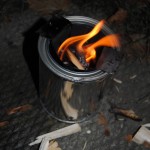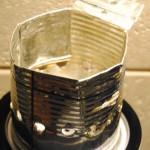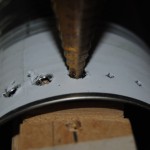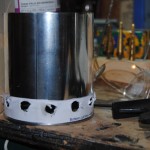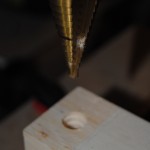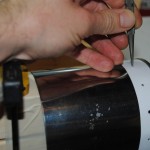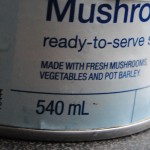I was interested in trying out the Wood Gas Stove I saw an article on in Make (Vol. 27 Wood Gas Stove by William Abnerthay) and so set-to assembling the tools and materials. Although I found the step drill bit at Lowe’s, I found it at almost half the price at Princess Auto and ended up buying a package of three plus and extra for metal for the same price I would have paid at Lowes. Since the article in Make is in American units I had to search around and try a few different sizes before finding that the 19oz. can is equal to a 540 mL can of soup, and would fit the paint can I bought from Home Hardware. I ended up using a fruit can for the third can, which ultimately sat inside. Another fruit can served as the chimney.
The step drill bit is really fantastic. It works well in both the hand drill and the drill press. It’s important to pre-punch the holes in the can with an awl or nail or something in order to get the placement of the bit right. I also found that with the hand drill I could just push the tip into the soft metal from the can and it would start where I wanted it to. I noticed this after taking a great amount of time lining everything up and being really precise — only to realize that I’d made a mistake somewhere and wasted time.
The stove proved to be a bit finicky. It was definitely not smokeless. I was able to get it going quickly — cheating with a bit of lighter fluid, but also getting results with wood shavings and patience — but learned that it would burn out quickly. Nevertheless, I was able to get a hot little fire going with very little fuel and once the coal bed was established, the fire would re-start if I was patient. I used about 6 inches of 2×2 pine to burn the stove for about an hour.
The stove did burn all the fuel very efficiently; there was nothing other than charcoal and ashes left. I noticed a lot of tar as a result of the burn, and I did get some of it on the bottom of a pan I was trying to boil water in. That kind-of sucks, because it’ll make it very difficult to travel with the any-such coated pots; they also stink like the Dickens. Unless you, like, really love the smell of camping. Maybe I should cross-market this as an essence-of-cooking aroma extraction device for those people who really dig that kind of thing.
I didn’t actually manage to boil water, though. For example, I started a fire at 10:49 and still hadn’t managed to boil less than a cup of water by 11:23.I used a meat thermometer and it started at a reading of 17 degrees C, rising to 71 degrees C, but no farther. Not what I was expecting. I tried again today and I think that with a steady supply of fuel and a feed opening in the chimney to get the fuel into the fire, I might actually be able to boil water. If you set low standards, they’re easier to accomplish. But the fire would take a lot of tending — do-able, but perhaps a bit tedious.
All in all, a fun little project that I’ll try to improve on and actually put in action at an upcoming winter camp.
